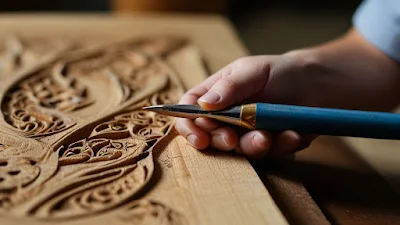Woodcarving, the art of transforming wood into intricate sculptures and forms, is a meditative and rewarding pursuit. But before you embark on this creative journey, equipping yourself with the proper tools is essential. Among these tools, your knives reign supreme. Selecting the right ones and maintaining them meticulously will ensure clean cuts, precise details, and a frustration-free carving experience.
Picking Your Partners: A Guide to Woodcarving Knives
When it comes to woodcarving knives, a one-size-fits-all approach doesn't exist. Each knife serves a specific purpose, and having a well-curated collection allows you to tackle various aspects of your project. Here's a breakdown of some essential knives to consider:
- Roughing Knife: This powerhouse features a hefty blade ideal for removing large chunks of wood and shaping the overall form.
- Detailing Knife: A smaller, more precise knife perfect for intricate cuts, delicate features, and adding depth to your carving.
- Chip Carving Knife: This specialized knife boasts a straight blade for creating crisp lines and geometric patterns, often used in chip carving.
- Degouge Knife: Featuring a U-shaped blade, the degouge excels at scooping out curved sections and hollowing out forms.
- Veiner Knife: This V-shaped knife comes in handy for carving grooves, veins, and adding realistic textures to your creation.
Sharpening Your Skills: The Art of Maintaining Woodcarving Knives
Just like a sculptor needs a sharp chisel, a woodcarver relies on a keen blade. A blunt knife not only makes carving laborious but also increases the risk of slipping and injury. Here's how to keep your knives razor-sharp:
- Sharpening Stones: Invest in a good quality whetstone or diamond sharpening stone for honing your blades.
- Sharpening Technique: Master the proper sharpening angle specific to your knife type. Online tutorials and woodworking stores can provide valuable guidance.
- Honing Regularly: Develop a routine of sharpening your knives before each carving session or whenever you feel resistance while cutting.
- Strop for Polishing: After sharpening, use a leather strop charged with honing compound to achieve a polished, razor-sharp edge.
- Safety First: Always wear appropriate safety gear like cut-resistant gloves and eye protection while sharpening.
Consultation Corner: Addressing Your Woodcarving Knife Concerns
Feeling a little lost in the world of woodcarving knives? Don't fret! Here's how I can help:
- Choosing Starter Knives: If you're a beginner, I can recommend a basic starter set that covers the essential functionalities for your initial projects.
- Speciality Knife Selection: For specific carving styles or advanced techniques, I can guide you towards specialized knives that will elevate your craft.
- Sharpening Tips and Tricks: Having trouble achieving that perfect edge? I can share helpful resources and techniques to ensure your knives stay sharp.
- Maintaining Your Collection: Unsure about proper storage or how to prevent rust? I've got tips for keeping your treasured knives in top condition.
- Safety Precautions: Always prioritize safety. I can provide reminders and best practices to prevent accidents while woodcarving.
With the right knowledge and tools, woodcarving can be a truly enriching experience. Remember, selecting the appropriate knives for your project and maintaining them meticulously will allow you to translate your vision into stunning carved creations. So, delve into this rewarding art form, and don't hesitate to reach out if you have any questions along the way. Happy carving!

